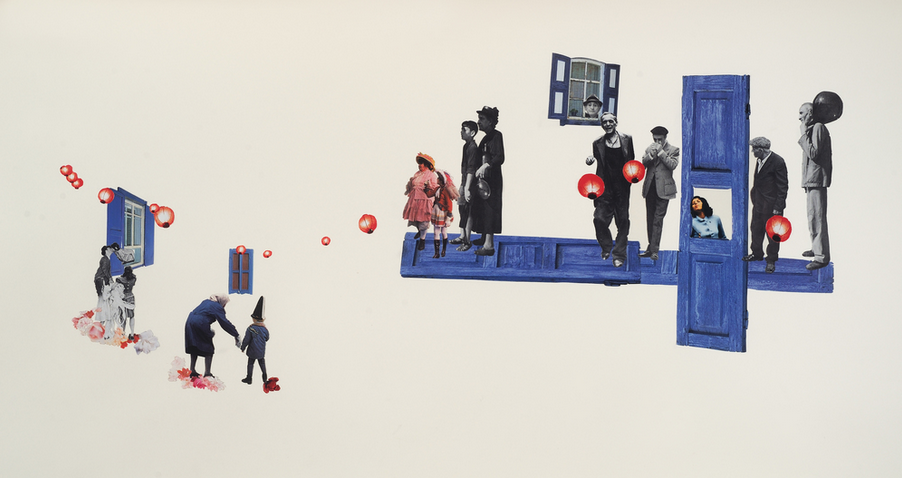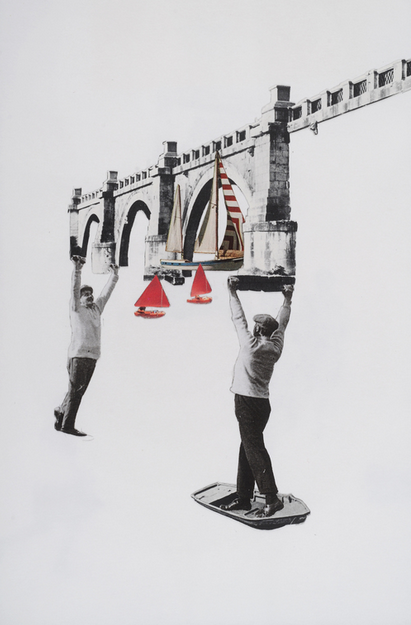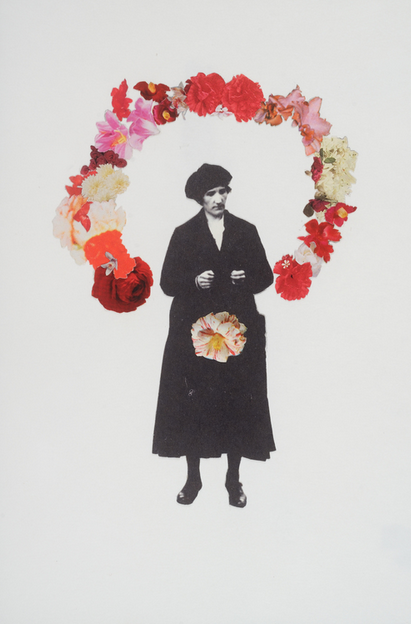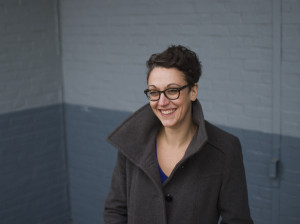
credit: Rachel Farbiarz
Poet, scholar, and translator Stefania Heim, author of A Table that Goes on for Miles, talks with TBQ editor Jane Carr
TBQ: First, congratulations on the publication of A Table that Goes on for Miles. Can you tell us about the process of making the book? How long were you working on the manuscript and what common ideas link its elements together?
A Table that Goes on for Miles represents more than a decade of work, from start to finish. It began as my MFA thesis at Columbia University, called, at the time, “Anywhere but Anywhere Else,” which is a line from a poem that no longer appears in the collection. For many years, the manuscript had a revolving door: new poems would come in and older ones would get immediately booted. All the while I was working and re-working, circling around language, ideas, and images that felt urgent, but that I hadn’t been able to (or probably at that time didn’t entirely want to) articulate as a coherent project. After about eight years of this experimenting and collecting and whittling, I decided that, though I could go on playing forever, it was probably time to start sending the manuscript out. When Brenda Shaughnessy chose it for Switchback’s Gatewood Prize, I think it was still very much a manuscript. It wasn’t until working with the amazing editorial team at Switchback – who had all intensely read and thought about the collection – and in particular trying to answer Hanna Andrews’ smart and difficult questions, that I was able to describe an overarching vision for the book and create a structure that enacted that vision. At this point in the process, my great friend, the artist Rachel Farbiarz, made a series of collages in conversation with the poems – her work is on the cover of the book and appears throughout. It has been thrilling to see my own language become embodied in this way.
At the most basic level Table investigates how we understand and invent ourselves in relation to versions of ourselves (both quotidian and fantastic), to others (real and imagined, known and unknown), and to the world around us (natural and man-made). I try to probe these relations, as well as their construction and representation in language: what does it sound and feel like when we tell different kinds of stories; how do we orient ourselves or lose ourselves through the process and trappings of narrative? There are different kinds of poems: dream poems, film noir poems, poems in conversation with Freud or Luigi Pirandello or Ralph Waldo Emerson. I’ve come to think about the collection as a physical table, at once concrete and surreal, around which my various interlocutors and selves gather, laugh, drink, weep, remember, theorize, and argue.

credit: Rachel Farbiarz
TBQ: If you were invited to read for an ideal audience, which three poems from the book would you perform aloud?
One of the things that’s been so exciting about holding this long-gestating project as an actual bound book is that it has allowed me to have a changed relationship with the work inside, to rediscover forgotten pieces and see new relationships in what is there. Which is to say, I would probably answer this completely differently tomorrow from today. One poem I’ve been recently excited to read aloud is “Considering the Limitations of the Force of My Will,” which is probably the only piece in the book that came out whole, as a sort of fever dream: it has a ton of repetition and plays with the different meanings of “to want.” In general, the last section of the book is my favorite, and my answer today is that I would also read “A Third Party Who Says Me” (in which “We move each other / around”) and “Saturday, and Getting Colder” (in which I leave my handbag at the scene of the crime) to my distinguished imaginary audience.
TBQ: The phrase that really stands out from all the praise your book has received comes from Elizabeth Willis – she says it’s full of “transformative generosities.” Where and what forces, images, aspects of language are transformative for you?
There’s a moment in Elizabeth Willis’s incredible book, Meteoric Flowers, where she commands, “for word, read world.” It is this gesture – in which a word doesn’t so much become another word but shows itself already to contain the potential of that word, even as it remains itself – that for me is the shimmering essence of the transformative in poetry. Every time you read “word” (or for that matter any word) in the rest of Elizabeth’s book, it is “word” and the entire “world” at once. The poems become like crystals or fractals. You don’t have to choose. I love how a gesture like this is not teleological – it doesn’t suggest there is a straightforward or normative direction in which transformation happens, or should happen. Sound has its own logic that both masquerades as and creates other registers of logic.
In my poem, “Serenissima” (which is about Venice, that most amphibian of all cities), I write, “What I fear is transformation” – and I’m wondering now about the difference between the transformative and transformation. Many years ago I lived up at 192nd Street in Manhattan, and frequently, at night, I would be the only person in my car of the A train traveling uptown. This would terrify me, but not because I feared some actual danger – a person with a gun or a knife. It terrified me because without another person present I imagined that the train-car might suddenly enter another dimension, or simply cease to exist. That alone, there was nothing tethering me to my reality.
TBQ: At AWP in Seattle, you moderated a panel called “Translating Radical Women Poets,” which focused in part on the “historical and political importance and practical complexity” of translating the work of radical women poets. Can you tell us some of your favorite moments from this discussion? What makes a “radical woman poet,” and in a broader sense, what constitutes radical poetics?
In my introductory comments for the panel I talked about the etymology of “radical.” It comes from the Latin radici, or roots. In its early usage in English, “radical” clung to these “roots,” and it meant: “fundamental or inherent in the natural processes of life, vital.” Of course, now we think of “radical” in terms of the connotations it has accrued since the 19th century, largely in association with Leftist politics. The radical is “characterized by independence of or departure from what is usual or traditional.” The panel was situated in the productive tension created by these opposing definitions. I think it is extremely exciting, in the first place, to think about women poets as the sites of the radical, precisely in these simultaneous and frictional senses of life-giving roots and departure from tradition. (In the case of women you always have to wonder if “departure from tradition” hides within it someone’s insidious idea of a departure from responsibility.) And translation – that radical act – invites and necessitates a similar push-pull. Rootedness in the original is essential. But departure is, too: without it, the mind faces no rupture or complication that forces it to witness itself trying to make meaning; without it a reader might pretend equivalence where such a gesture would be dangerous and totalizing.
More than providing stable or comprehensive answers to what makes a radical woman poet or what constitutes radical poetics, the panelists – all radical woman poet-translators themselves – explored the real stakes and implications of these categories in the work, lives, and bodies of women whose work they translate. It was an incredibly effective, and also incredibly moving, point of entry. Their examples varied widely in terms of aesthetics, language, and history: Don Mee Choi spoke about contemporary Korean poet Kim Hyesoon, Jen Hofer about contemporary Uruguayan poet Virginia Lucas, Jennifer Kronovet about early 20th-century Yiddish-language poet Celia Dropkin, and Jennifer Scappettone about 20th-century macaronic/Italian poet Amelia Rosselli. And beyond these brilliant presentations, the panel had some exciting elements of performance – of ideas embodied – as well. Don Mee, who read from Kim Hyesoon’s “Pinkbox,” hand-made each of us a pink box to wear on our heads – folded pink box, dented pink box – strange and beautiful objects which held stanzas from the poem. During her presentation, Jen Hofer invited the audience (100-plus people, practically all of whom were women!) to come to the front of the room and look at images of an installation she and John Pluecker – who together founded Antena, the language justice and language experimentation collaborative – created at the University of Houston, while she read from their “Manifesto for Ultratranslation.” This element was, admittedly, Jen’s improvisation born from our failure to achieve the appropriate media hook-up, but it added to the real sense of urgency, disruption, and possibility in the room – as “mistakes” so frequently do.
TBQ: In our first issue, we adapted a roundtable on a similar topic, the presence of social argument and politics in fiction. What were some of the persistent questions or conclusions reached during the panel about “new ways to speak and think here and now about poetics, politics, and gender?”
In one of the most illuminating moments of the panel, Don Mee Choi confessed that Kim Hyesoon is surprised that her work is perceived as political in the U.S. Obviously this has a lot to do with Don Mee’s positioning of Kim Hyesoon’s translations within contemporary poetic contexts here, but it also speaks to the constructedness, permeability, and historical and cultural boundedness of categories like radical and political. Though Kim Hyesoon writes against and outside of prescribed Korean literary conventions for women, “political” poetry in Korea is something else, a very specific category in which she is not included. In a related vein, though contemporary readers probably will not find Celia Dropkin’s Yiddish poems to be wildly transgressive or unfamiliar in their graphic, sometimes grotesque engagement with the female body, Jennifer Kronovet read from some damning critiques of her poems written in the early 20th-century that show how these elements made her radical among her cohort and in her time – and how such radicality was deeply political (and deeply gendered) in its attendant arguments about who should talk about what and where.
I think that these two examples – and there are countless others – speak to the power of rigid categories to forestall, or blind us to the necessity of, deep and difficult engagement with poems and poets themselves. Speaking and thinking newly here and now about poetics, politics, and gender requires more concrete and direct consideration of the ways that literature is embedded in and related to other aspects and structures, not just of writing and thinking, but also of living (now, in the past, and in the future). We should ceaselessly interrogate – and probably upend – most of our categories.
TBQ: Let’s bring translation into the mix here as well. What acts, skills, improvisations, and charms of translation do we most need as readers (or writers)? What is most critical and valuable about the work of translation, from a reader’s perspective?
This might seem obvious, but I think it can’t be said enough: as readers, what we need more than anything from translation is to remember and acknowledge that it exists, that translation happens, is happening. The illusion of transparency, the myth of the faithful or seamless translation – what Larry Venuti exposed and theorized two decades ago as “the translator’s invisibility” – these false dreams still seem to hold sway over so many well-meaning readers. And it makes sense because translation is scary – it requires not being sure, experimenting, inventing, risking failure, risking going too far, risking not going far enough, taking responsibility for your relationships to your language and to other languages, to yourself and to those around you.
I would say that practices of reading in translation – practices that respect and celebrate (even while they are busy constructing temporary bridges over, or projectiles across) the gaps between languages, the gaps between things and our words for them, the gaps between ourselves and the world, the gaps between people – should color and animate any and all reading and writing we do.

credit: Rachel Farbiarz
TBQ: As the co-founder of Circumference, a journal dedicated to supporting poetry in translation and a critic and poet who has done translation work herself, what do you think are the most pressing cultural issues around translation at the moment? Do they relate to why you wanted to start the journal?
When Jennifer Kronovet and I started Circumference in 2003, we wanted the journal to be a vital, living place where people could get the news about and from poetry being written around the world. We were both young poets, deeply immersed in the world of little magazines and presses, and we wanted to contribute to that culture. But we were also aspiring translators and readers for whom many of our seminal, writer-making moments and texts were in languages other than English. Bridging those two orientations, we felt that the new translations and new international work we published belonged on bookstore shelves beside contemporary poems in English. That was the conversation we wanted to extend, expand, and take part in.
I think that the most pressing cultural issues around translation currently circle around questions of context and placement. Ammiel Alcalay has repeatedly pointed out the problematic attitude of American audiences who applaud themselves for reading in translation even as they approach those translations like exotic treats, disconnected from the messiness of cultural or political histories and facts. Instead of paraphrasing, I’ll quote him on this subject from his excellent book a little history: “The key … is not to treat someone … as simply a window into another world but as a means of finding our own … [To understand] how necessary it is not just to preserve [cultural materials] but to reanimate the contexts in which they were created.”
TBQ: In your view, who are some of the best and most exciting translators working today? Who should we be promoting to our readers?
Oh, there are so many! I am one of the judges for this year’s Best Translated Book Award for Poetry and it has been thrilling to see the breadth and energy of works in translation published in just the past year. Instead of naming individual translators – it would be impossible to come up with a list that is both satisfying and digestible – I’ll point to a few of the small presses that keep tirelessly and gorgeously putting out truly exciting translations: Action Books, Ugly Duckling, Zephyr, Burning Deck, Litmus Press/Aufgabe, New Directions.
TBQ: What is (or what should be) the role of the critic in politics and culture?
To continue on my “context” train, I think it should be the role of the critic to produce thick and robust understandings of cultural works that place them in their myriad contexts – literary, historical, and human. To understand how pieces of writing act in and enact the world. To put things in perspective. To make connections. To upend easy or faulty assumptions (that frequently come from those pesky rigid categories I mentioned earlier). To ask: Where does a piece of writing come from? What is it about? Who or what is it in conversation with? Why do or should we care? I think critics must do the hard work of reading (not assuming, not reducing). They should make arguments about texts. They should have arguments with others. I want my critics to take poetry seriously, not just as production but as thought. As feeling, too. Finally, I think part of the critic’s job is harnessing energy, being excited, creating excitement.
TBQ: You’ve studied and taught in a variety of institutions as a writer and scholar. Can you describe some of the most valuable things you have learned in the classroom – from your teachers and from your students?
One of the best things about teaching is that it forces you to put your money where your mouth is. A year into my doctoral studies at the CUNY Graduate Center I started teaching “Introduction to Literature” at Hunter College. It is one thing to study, interpret, and argue over difficult texts with others who have also decided to commit their lives to that same struggle, and quite another to convince a roomful of business and nursing majors at 8 p.m. on a Thursday, after many of them have worked a full and exhausting day, that Walt Whitman’s verb tenses or Gwendolyn Brooks’ alliteration really matter. The thing is, I do think they matter – I think they matter because I think language matters, and not just theoretically.
This semester I’m teaching an investigative poetry course at Deep Springs College. An educational experiment in the California high desert, Deep Springs was founded to train young men for “lives of service” through engagement with three pillars: academics (students take a full and intense course load), labor (they work on the ranch and alfalfa farm, in the office and in the kitchen) and self-governance (they create by-laws, hire faculty, admit other students). The college is also a community: faculty, staff, and students take all their meals in the Boarding House; we go on walks and hikes; we are literally together all the time. Arriving at Deep Springs I realized immediately how much of a teacher’s authority normally derives from distance. Such mystery or decorum, such automatic power is just not available here: my students see me – day after day – as I beg my daughter to try a lamb chop or some rice, as I cringe at my husband’s corny jokes (he is also their teacher), as I stumble out of our apartment only midway through my first coffee. Also, they hired me, so in that sense, they are my boss – charged with evaluating my performance as much as I am theirs. What I am learning here is how to be a teacher and a leader in such a vulnerable, messily human context – it is hard, but it feels invigorating and true. I’m excited to see if and how I will have the guts to bring elements of this experience to other, more conventional classrooms, where I don’t have to be quite so exposed.
TBQ: What are your next planned adventures? Are you working on new material?
Putting the Table manuscript to bed has meant being able to dive headlong into other poetic projects, and I have been working on two in particular. Hour Book is a collection of time-stamped lyrics (poems titled with the moment of initiation of composition, say 2:34 p.m.) through which I try to understand the concrete work that ideas of time do in constructing, organizing, and giving significance to our lives. I think about it as trying to turn the abstraction of time into a space we can enter and examine through intensive attention to its accidents and structures. In Still Death, on the other hand, I look closely at a series of images, including gruesome police evidence, miniature forensic murder scenes, and black and white photographs of empty urban spaces, to create what I like to call crime scene investigations that use poetic language to probe the emotional power and narrative significance of such images. This second project grows from my life-long love of the detective story.
I’m also hard at work finishing my dissertation, which is called Dark Matter: Susan Howe, Muriel Rukeyser, and the Scholar’s Art – and doing a bunch of projects and presentations that grow from that research. I just collaborated on editing a chapbook of Adrienne Rich’s pedagogical materials from her time working at CUNY; those have come out through Lost & Found: The CUNY Poetics Document Initiative. And I’ve recently joined the Boston Review as a Poetry Editor – it’s been thrilling starting to put my ideas about the critic’s role that you asked about into some kind of interactive practice or conversation. Finally, Jenny Kronovet and I are cooking up an anthology on the topic of our AWP panel: translating radical women poets.
TBQ: We are looking forward to all of that and more.
•

image: Youngsuk Suh
Stefania Heim is the author of A TABLE THAT GOES ON FOR MILES (Switchback Books 2014), which was selected by Brenda Shaughnessy as winner of the 2012 Gatewood Prize. Her poems, essays, and translations have also appeared in publications including A Public Space, Aufgabe, Harper’s Magazine, Jacket2, The Journal of Narrative Theory, The Literary Review, the Paris Review, and other publications. She holds an A.B. in Literature from Harvard College, an MFA in Poetry from Columbia University, and is currently completing a PhD in English from the CUNY Graduate Center. In addition to teaching at Columbia University, Deep Springs College, and Hunter College, she is a Poetry Editor at the Boston Review and a Founding Editor of CIRCUMFERENCE: Poetry in Translation.
